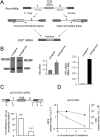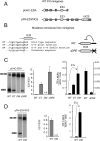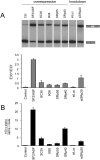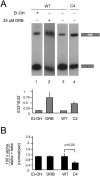First come, first served revisited: factors affecting the same alternative splicing event have different effects on the relative rates of intron removal
- PMID: 20357345
- PMCID: PMC2856885
- DOI: 10.1261/rna.1993510
First come, first served revisited: factors affecting the same alternative splicing event have different effects on the relative rates of intron removal
Abstract
Alternative splicing accounts for much of the complexity in higher eukaryotes. Thus, its regulation must allow for flexibility without hampering either its specificity or its fidelity. The mechanisms involved in alternative splicing regulation, especially those acting through coupling with transcription, have not been deeply studied in in vivo models. Much of our knowledge comes from in vitro approaches, where conditions can be precisely controlled at the expense of losing several levels of regulation present in intact cells. Here we studied the relative order of removal of the introns flanking a model alternative cassette exon. We show that there is a preferential removal of the intron downstream from the cassette exon before the upstream intron has been removed. Most importantly, both cis-acting mutations and trans-acting factors that regulate the model alternative splicing event differentially affect the relative order of removal. However, reduction of transcriptional elongation causing higher inclusion of the cassette exon does not change the order of intron removal, suggesting that the assumption, according to the "first come, first served" model, that slow elongation promotes preferential excision of the upstream intron has to be revised. We propose instead that slow elongation favors commitment to exon inclusion during spliceosome assembly. Our results reveal that measuring the order of intron removal may be a straightforward read-out to discriminate among different mechanisms of alternative splice site selection.
Figures





Similar articles
-
Cis-acting intronic elements that regulate cartilage-specific alternative splicing of the type II collagen (Col2) pre-mRNA lie at or near splice site junction sequences flanking exon 2 of the gene.J Bone Miner Res. 2003 Sep;18(9):1716-22. doi: 10.1359/jbmr.2003.18.9.1716. J Bone Miner Res. 2003. PMID: 12968682
-
Perturbation of transcription elongation influences the fidelity of internal exon inclusion in Saccharomyces cerevisiae.RNA. 2003 Aug;9(8):993-1006. doi: 10.1261/rna.5390803. RNA. 2003. PMID: 12869710 Free PMC article.
-
Pre-mRNA splicing is facilitated by an optimal RNA polymerase II elongation rate.Genes Dev. 2014 Dec 1;28(23):2663-76. doi: 10.1101/gad.252106.114. Genes Dev. 2014. PMID: 25452276 Free PMC article.
-
Exon and intron definition in pre-mRNA splicing.Wiley Interdiscip Rev RNA. 2013 Jan-Feb;4(1):49-60. doi: 10.1002/wrna.1140. Epub 2012 Oct 8. Wiley Interdiscip Rev RNA. 2013. PMID: 23044818 Review.
-
Combinatorial control of exon recognition.J Biol Chem. 2008 Jan 18;283(3):1211-5. doi: 10.1074/jbc.R700035200. Epub 2007 Nov 16. J Biol Chem. 2008. PMID: 18024426 Review.
Cited by
-
Circular RNAs are the predominant transcript isoform from hundreds of human genes in diverse cell types.PLoS One. 2012;7(2):e30733. doi: 10.1371/journal.pone.0030733. Epub 2012 Feb 1. PLoS One. 2012. PMID: 22319583 Free PMC article.
-
Pre-mRNA splicing during transcription in the mammalian system.Wiley Interdiscip Rev RNA. 2011 Sep-Oct;2(5):700-17. doi: 10.1002/wrna.86. Epub 2011 May 2. Wiley Interdiscip Rev RNA. 2011. PMID: 21823230 Free PMC article. Review.
-
R-loops at microRNA encoding loci promote co-transcriptional processing of pri-miRNAs in plants.Nat Plants. 2022 Apr;8(4):402-418. doi: 10.1038/s41477-022-01125-x. Epub 2022 Apr 21. Nat Plants. 2022. PMID: 35449404 Free PMC article.
-
The Krebs Cycle Connection: Reciprocal Influence Between Alternative Splicing Programs and Cell Metabolism.Front Oncol. 2018 Sep 26;8:408. doi: 10.3389/fonc.2018.00408. eCollection 2018. Front Oncol. 2018. PMID: 30319972 Free PMC article. Review.
-
An Unusual U2AF2 Inhibits Splicing and Attenuates the Virulence of the Human Protozoan Parasite Entamoeba histolytica.Front Cell Infect Microbiol. 2022 Jun 17;12:888428. doi: 10.3389/fcimb.2022.888428. eCollection 2022. Front Cell Infect Microbiol. 2022. PMID: 35782149 Free PMC article.
References
-
- Aebi M, Weissmann C 1987. Precision and orderliness in splicing. Trends Genet 4: 102–107
-
- Beyer AL, Osheim YN 1988. Splice site selection, rate of splicing, and alternative splicing on nascent transcripts. Genes & Dev 2: 754–765 - PubMed
-
- Cramer P, Caceres JF, Cazalla D, Kadener S, Muro AF, Baralle FE, Kornblihtt AR 1999. Coupling of transcription with alternative splicing: RNA pol II promoters modulate SF2/ASF and 9G8 effects on an exonic splicing enhancer. Mol Cell 4: 251–258 - PubMed
Publication types
MeSH terms
Substances
LinkOut - more resources
Full Text Sources
